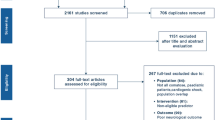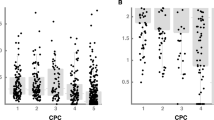Abstract
Purpose
To review the predictive powers of SEPs in comatose children after acute brain injury.
Methods
MEDLINE, EMBASE, OVID, ISI Web of Knowledge, BIOMED Central and the Cochrane Library (1981–2007) were searched. First, predictive values were calculated for each primary study. Second, we analysed effects of different factors on the SEP diagnostic odds ratio by meta-regression. Third, we compared SEP predictive values in children and in adults.
Results
We selected 14 studies covering 732 patients; analysis was conducted in 11, while the other 3 were used for simple qualitative examination. In individual papers, the presence of SEP predicted favourable outcomes as shown by the area under both sROC curves being 0.958. The same value was shown by SEP absence for predicting unfavourable outcomes. All covariates showed no significant effects on diagnostic accuracy, but only a slight non-significant trend. For SEP grading, a simple sub-group analysis showed a high predictive value for non-awakening for absence of SEPs (PPV 97.0%) and a high prognostic power to predict awakening for normal SEPs (PPV 92.2%). Pathological SEPs did not show reliable predictivity. In children, the presence of SEPs showed a high prognostic power similar to that in adults.
Conclusion
This study supports the use of SEPs in the integrated process of outcome prediction after acute brain injury in children. Caution is recommended in predicting unfavourable outcomes in patients with an absence of SEPs in both TBI and HIE comas. Future studies are needed to resolve the issue of the effect of aetiology and age on SEP's predictive power.








Similar content being viewed by others

References
Ashwal S (2004) Pediatric vegetative state: epidemiological and clinical issues. Neuro Rehabil 19:349–360
Carter BG, Butt W (2001) Review of the use of somatosensory evoked potentials in the prediction of outcome after severe brain injury. Crit Care Med 29:178–186
Robinson LR, Micklesen PJ, Tirschwell DL, Lew HL (2003) Predictive value of somatosensory evoked potentials for awakening from coma. Crit Care Med 31:960–967
Carter BG, Butt W (2005) Are somatosensory evoked potentials the best predictor of outcome after severe brain injury? A systematic review. Int Care Med 31:765–775
Wijdicks EF, Hijdra A, Young GB, Bassetti CL, Wiebe S, Quality Standards Subcommittee of the American Academy of Neurology (2006) Practice parameter: prediction of outcome in comatose survivors after cardiopulmonary resuscitation (an evidence-based review). Report of the quality standards subcommittee of the American Academy of Neurology. Neurology 67:203–210
Sterne JA, Egger M (2001) Funnel plots for detecting bias in meta-analysis: guidelines on choice of axis. J Clin Epidemiol 54:1046–1055
Whiting P, Rutjes AW, Reitsma JB, Bossuyt PM, Kleijnen J (2003) The development of QUADAS: a tool for the quality assessment of studies of diagnostic accuracy included in systematic reviews. BMC Med Res Methodol 3:25
Irwig L, Tosteson AN, Gatsonis C, Lau J, Colditz G, Chalmers TC, Mosteller F (1994) Guidelines for meta-analysis evaluating diagnostic test. Ann Intern Med 120:667–676
Sackett DL, Straus SE, Richardson SW, et al (eds) (2000) Evidence-based medicine. Harcourt Health Sci
Villanueva EV, Zavarsek S (2004) Evaluating heterogeneity in cumulative meta-analyses. BMC Med Res Methods 4:18
Higgins JPT, Green S (2008) Cochrane handbook for systematic reviews of interventions 5.0.1 [updated September 2008]. In: The Cochrane Library, issue 4, 2006. Wiley, Chichester
Moses LE, Shapiro D, Littenberg B (1993) Combining independent studies of a diagnostic test into a summary ROC curve: data analytic approaches and some additional considerations. Stat Med 12:1293–1316
van Houwelingen HC, Arends LR, Stijnen T (2002) Advanced methods in meta-analysis: multivariate approach and meta-regression. Stat Med 21:589–624
Carter BG, Butt W (2005) A prospective study of outcome predictors after severe brain injury in children. Int Care Med 2005(31):840–845
Schalamon J, Singer G, Kurschel S, Höllwarth ME (2005) Somatosensory evoked potentials in children with severe head trauma. Eur J Pediatr 164:417–420
Tomita Y, Fukuda C, Maegaki Y, Hanaki K, Kitagawa K, Sanpei M (2003) Re-evaluation of short latency somatosensory evoked potentials (P13, P14 and N18) for brainstem function in children who once suffered from deep coma. Brain Dev 25:352–356
Mandel R, Martinot A, Delepoulle F, Lamblin MD, Laureau E, Vallee L, Leclerc F (2002) Prediction of outcome after hypoxic-ischemic encephalopathy: a prospective clinical and electrophysiologic study. J Pediatr 141:45–50
Wohlrab G, Boltshauser E, Schmitt B (2001) Neurological outcome in comatose children with bilateral loss of cortical somatosensory evoked potentials. Neuropediatrics 32:271–274
Chéliout-Heraut F, Rubinsztajn R, Ioos C, Estournet B (2001) Prognostic value of evoked potentials and sleep recordings in the prolonged comatose state of children, preliminary data. Neurophysiol Clin 31:283–292
Carter BG, Taylor A, Butt W (1999) Severe brain injury in children: long-term outcome and its prediction using somatosensory evoked potentials (SEPs). Int Care Med 25:722–728
Pohlmann-Eden B, Dingethal K, Bender HJ, Koelfen W (1997) How reliable is the predictive value of SEP (somatosensory evoked potentials) pattern in severe brain damage with special regard to the bilateral loss of cortical responses. Intensive Care Med 23:301–308
Butinar D, Gostisa A (1996) Brainstem auditory evoked potentials and somatosensory evoked potentials in prediction of posttraumatic coma in children. Pflugers Arch 431(Suppl 2):R289–R290
Beca J, Cox PN, Taylor MJ, Bohn D, Butt W, Logan WJ, Rutka JT, Barker G (1995) Somatosensory evoked potentials for prediction of outcome in acute severe brain injury. J Pediatr 126:44–49
Zentner J, Rohde V (1994) SEP and MEP in comatose patients. Neurol Res 16:89–92
Goodwin SR, Bellefleur M, Friedman WA (1991) Is it time to use evoked potentials to predict outcome in comatose children and adults? Crit Care Med 19:518–524
Barelli A, Valente MR, Clemente A, Bozza P, Proietti R, Della Corte F (1991) Serial multimodality-evoked potentials in severely head-injured patients: diagnostic and prognostic implications. Crit Care Med 19:1374–1381
Facco E, Baratto F, Munari M, Donà B, Liviero MC, Behr AU, Giron GP (1991) Sensorimotor central conduction time in comatose patients. Electroencephalogr Clin Neurophysiol 80:469–476
Facco E, Munari M, Donà B, Baratto F, Fiore D, Behr AU, Giron G (1991) Spatial mapping of SEP in comatose patients: Improved outcome prediction by combined parietal N20 and frontal N30 analysis. Brain Topogr 3:447–455
Hutchinson DO, Frith RW, Shaw NA, Judson JA, Cant BR (1991) A comparison between electroencephalography and somatosensory evoked potentials for outcome prediction following severe head injury. Electroencephalogr Clin Neurophysiol 78:228–233
Judson JA, Cant BR, Shaw NA (1990) Early prediction of outcome from cerebral trauma by somatosensory evoked potentials. Crit Care Med 18:363–368
Lindsay K, Pasaoglu A, Hirst D, Allardyce G, Kennedy I, Teasdale G (1990) Somatosensory and auditory brain stem conduction after head injury: a comparison with clinical features in prediction of outcome. Neurosurgery 26:278–285
Parain D, Devaux AM, Proust B (1989) The contribution of EEG and evoked potentials in the post-anoxic prognosis of coma in children. Neurophysiol Clin 19:489–494
Taylor MJ, Farrell EJ (1989) Comparison of the prognostic utility of VEPs and SSEPs in comatose children. Pediatr Neurol 5:145–150
Zentner J, Ebner A (1988) Prognostic value of somatosensory and motor evoked potentials in patients with non-traumatic coma. Eur Arch Psychiatr Neurol Sci 237:184–187
Goldie WD, Price RH (1988) Recovery from “brain death” with absent evoked potentials. J Clin Neurophysiol 5:354
Ganes T, Lundar T (1988) EEG and evoked potentials in comatose patients with severe brain damage. Electroencephalogr Clin Neurophysiol 69:6–13
De Meirleir LJ, Taylor MJ (1987) Prognostic utility of SSEPs in comatose children. Pediatr Neurol 3:78–82
Whittle IR, Johnston IH, Besser M (1987) Short latency somatosensory evoked potentials in children. III. Findings following head injury. Surg Neurol 27:29–36
Sonnet ML, Floret D, Guillaume C, Fournet A, Motin J (1987) Les potentiels èvoqués chez les enfants comateux. Pediatrie 42:45–50
Cant BR, Hume AL, Judson JA, Shaw NA (1986) The assessment of severe head injury by short latency somatosensory and brain-stem auditory evoked potentials. Electroencephalogr Clin Neurophysiol 65:188–195
de Beyl DZ, Brunko E (1986) Prediction of chronic vegetative state with somatosensory evoked potentials. Neurology 36:134
Frank LM, Furgiuele TL, Etheridge JE Jr (1985) Prediction of chronic vegetative state in children using evoked potentials. Neurology 35:931–934
White LE, Frank LM, Furgiuele TL et al (1985) Outcome with somatosensory and brainstem auditory evoked potentials. Ann Neurol 18:417
Anderson DC, Bundlie S, Rockswold GL (1984) Multimodality evoked potentials in closed head trauma. Arch Neurol 41:369–374
Rumpl E, Prugger M, Gerstenbrand F, Hackl JM, Pallua A (1983) Central somatosensory conduction time and short latency somatosensory evoked potentials in post-traumatic coma. Electroencephalogr Clin Neurophysiol 56:583–596
Lütschg J, Pfenninger J, Ludin HP, Vassella F (1983) Brain-stem auditory evoked potentials and early somatosensory evoked potentials in neurointensively treated comatose children. Am J Dis Child 137:421–426
Greenberg RP, Newlon PG, Becker DP (1982) The somatosensory evoked potential in patients with severe head injury: outcome prediction and monitoring of brain function. Ann N Y Acad Sci 388:683–688
Lindsay KW, Carlin J, Kennedy I, Fry J, McInnes A, Teasdale GM (1981) Evoked potentials in severe head injury—analysis and relation to outcome. J Neurol Neurosurg Psychiatr 44:796–802
Goldie WD, Chiappa KH, Young RR, Brooks EB (1981) Brainstem auditory and short-latency somatosensory evoked responses in brain death. Neurology 31:248–256
Hume AL, Cant BR (1981) Central somatosensory conduction after head injury. Ann Neurol 10:411–419
Shewmon DA (2000) Coma prognosis in children part I: definitional and methodological challenges. J Clin Neurophysiol 17:457–466
Luerssen TG, Klauber MR, Marshall LF (1988) Outcome from head injury related to patient’s age. A longitudinal prospective study of adult and pediatric head injury. J Neurosurg 68:409–416
Vollmer DG, Torner JC, Jane JA et al (1991) Age and outcome following traumatic coma: why do older patients fare worse? J Neurosurg 75:S37–S49
Levi L, Guilburd JN, Linn S, Feinsod M (1991) The association between skull fracture, intracranial pathology and outcome in pediatric head injury. Br J Neurosurg 5:617–625
Adams RD, Victor M (1995) Principles of Neurology. McGraw-Hill, New York
Shevell M (2006) Office evaluation of the child with developmental delay. Semin Pediatr Neurol 13:256–261
Fiser DH (1992) Assessing the outcome of pediatric intensive care. J Pediatr 121:68–74
Boyer MG, Edwards P (1991) Outcome 1 to 3 years after severe traumatic brain injury in children and adolescents. Injury 22:315–320
Plum F, Posner JB (1983) The diagnosis of stupor and coma. FA, Davis
Bates D (2001) The prognosis of medical coma. J Neurol Neurosurg Psychiatry 71(suppl I):i20–i23
Wong CP, Forsyth RJ, Kelly TP, Eyre JA (2001) Incidence, aetiology, and outcome of nontraumatic coma: a population based study. Arch Dis Child 84:193–199
Abend NS, Licht DJ (2008) Predicting outcome in children with hypoxic ischemic encephalopathy. Pediatr Crit Care Med 9:32–39
Lown B (1979) Sudden cardiac death: the major challenge confronting contemporary cardiology. Am J Cardiol 43:313–328
O’Carroll PW, Alkon E, Weiss B (1988) Drowning mortality in Los Angeles county, 1976 to 1984. JAMA 260:380–383
Amantini A, Grippo A, Fossi S, Cesaretti C, Piccioli A, Peris A, Ragazzoni A, Pinto F (2005) Prediction of ‘awakening’ and outcome in prolonged acute coma from severe traumatic brain injury: evidence for validity of short latency SEPs. Clin Neurophysiol 116:229–235
Glasziou P, Irwig L, Bain C, Colditz G (2001) Systematic review in health care. Cambridge University Press, Cambridge
Acknowledgments
The authors thank Sonia Verdesca, MD (Neurological Rehabilitation Unit, Fond. Don C. Gnocchi, Centro Santa Maria agli Ulivi, Pozzolatico, Florence, Italy), for her helpful comments and suggestions during the English editing of the manuscript.
Author information
Authors and Affiliations
Corresponding author
Electronic supplementary material
Below is the link to the electronic supplementary material.
Rights and permissions
About this article
Cite this article
Carrai, R., Grippo, A., Lori, S. et al. Prognostic value of somatosensory evoked potentials in comatose children: a systematic literature review. Intensive Care Med 36, 1112–1126 (2010). https://doi.org/10.1007/s00134-010-1884-7
Received:
Accepted:
Published:
Issue Date:
DOI: https://doi.org/10.1007/s00134-010-1884-7



